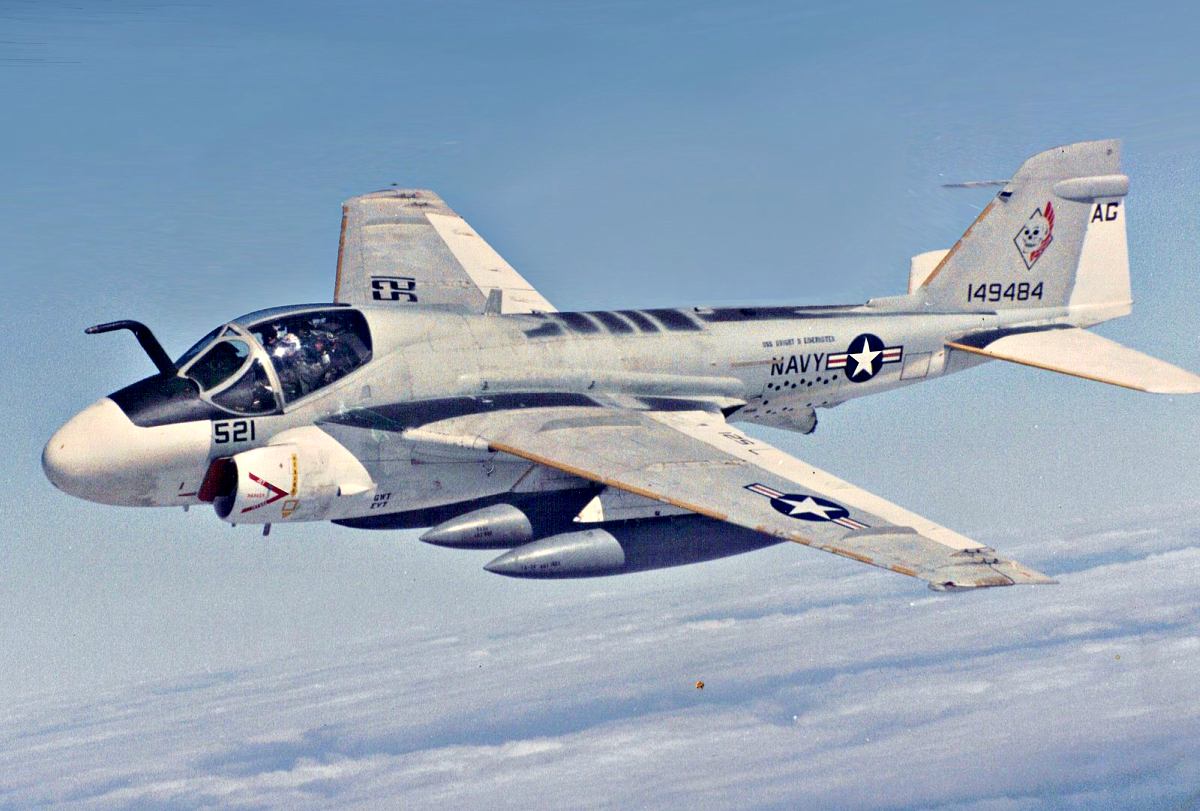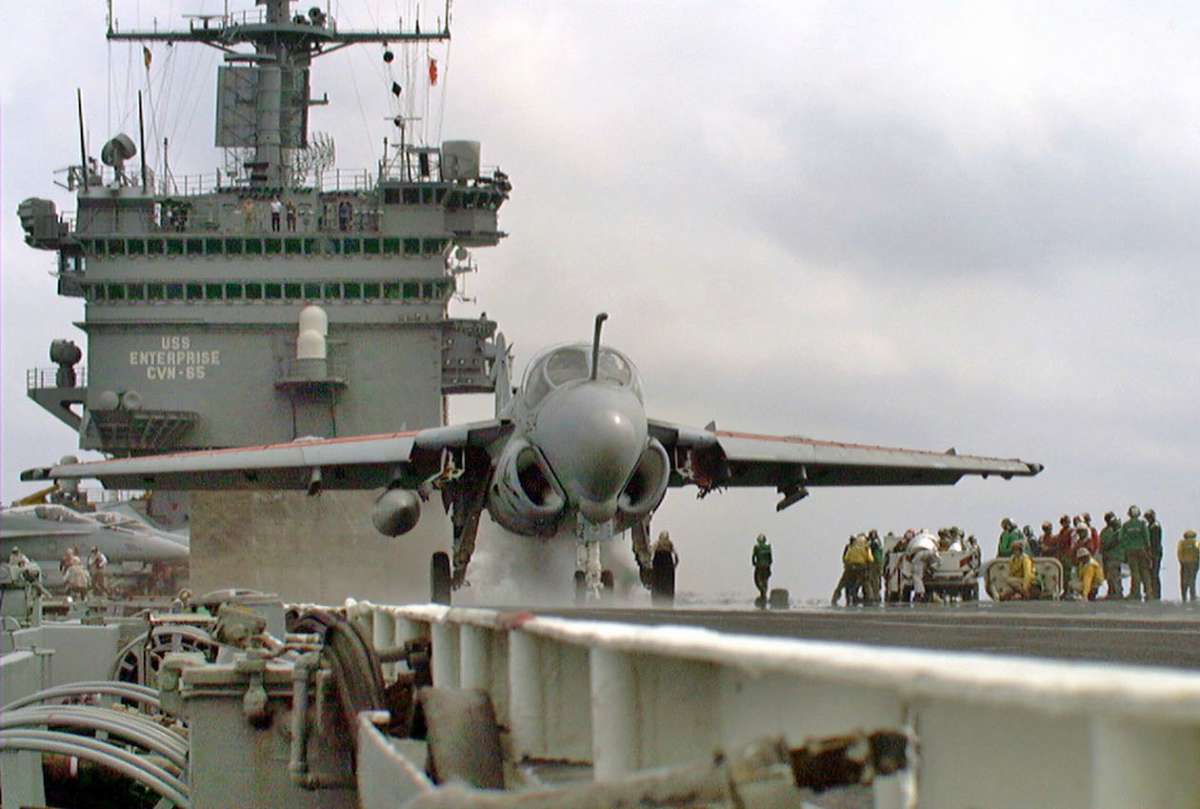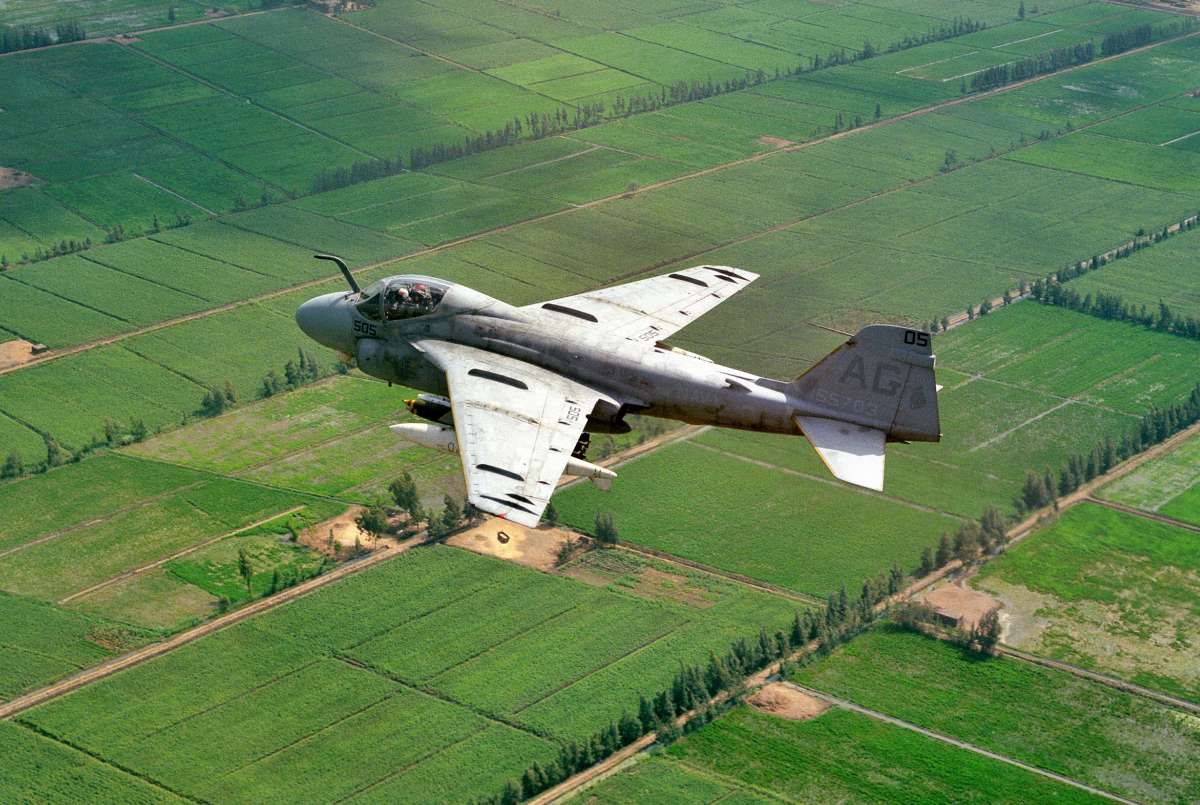Grumman A-6 Intruder
The United States Navy needed an all-weather carrier-based attack aircraft. The Douglas A-1 Skyraider did its job in the Korean War, but they desired a new aircraft with twin jet engines. The Grumman A-6 Intruder was introduced in 1963 and served as the Navy’s and Marine Corps’ premier medium/all-weather attack aircraft all the way through the 1990s.
A-6 Intruder Design
The Navy issued a request for proposals in 1956 and Boeing, Lockheed, Bell, Grumman, Douglas, Martin, Vought and North American submitted 11 designs for a two-seat, subsonic attack bomber. The Navy requested side-by-side seating in order to increase workload in the cockpit. Grumman A2F-1, which led to the A-6, received the contract and production began in 1958.
The A-6 Intruder was a notoriously ugly plane. Pratt & Whitney turbojets required twin intakes toward the front of the aircraft – swelling the sides and giving the A-6 a bloated look. The rounded snout and streamlined back end gave way to a joke that the plane was built backwards. Additionally, a refueling probe stuck out from the nose and was bent forwards making it look like a bug’s antenna. Some referred to the A-6 Intruder as “The Flying Drumstick”.

But don’t let looks deceive you. The A-6 Intruder’s avionics system was ahead of its time, its bombing prowess was immediately noticed, and its side-by-side seating arrangement created a sense of camaraderie rarely seen in other aircraft.
A-6 Intruder Cockpit
The pilot sat on the left and the bombardier/navigator sat on the right. Both Navy and Marine Corps pilots liked this setup because it allowed the navigator more access to be productive. Bombardier/navigators were responsible for monitoring airspeed, power settings, rate of descent, and altitude among others. And since they were right next to each other, communicating through pointing, nodding or eye contact was possible and further enhanced the crew’s effectiveness.
During training, A-6 pilots and navigators were often reminded they had to operate as one mind working cohesively. There was no room for individuals flying Intruders. The bombardier/navigator received the same medal as the pilot if one was given.

A-6 Intruder Capabilities
The A-6 Intruder was an all-weather aircraft. But due to its subsonic speeds just above treetop height, most missions were flown at night or in poor weather. Vietnamese MiGs located enemy aircraft best in broad daylight. The Intruder stayed under enemy radar and hit targets, even small or moving ones, with precision.
Intruder’s avionics system included Forward Looking Infrared (FLIR), laser targeting, Low Light Level TV (LLLTV) and Moving Target Identification (MTI). However, DIANE was the biggest advancement in its electronic hardware.
Digital Integrated Attack and Navigation Equipment (DIANE) was essentially a bomb release tool. DIANE could incorporate any speed, rate of climb, angle of dive, G force, wind or altitude and calculate the proper time to release a payload. DIANE’s Vertical Display Indicator gave the pilot a representation of the horizon, sky, terrain, radar altitude and angle of attack. This tool allowed the A-6 to hug terrain, which gave it its low-level bombing prowess.
Developments and versions of the A-6 continued to evolve. For instance, the A-6 was as a tanker in addition to its regular duties. Versions went from the A-6A to A-6E and the Intruder eventually gave way to the electronic attack aircraft EA-6B Prowler.

A-6 Intruder Association
The camaraderie of the pilots and navigators, as well as crew members, was so tangible that the A-6 Intruder Association was founded and still operates at a high capacity today. The Intruder Association is a non-profit fraternity created to facilitate and maintain contact between Intruder community members.
See A-6 Intruder Specifications
| Length:54 feet 7 inches (16.1 meters) |
| Height:15 feet 7 inches (4.74 meters) |
| Wingspan:53 feet (16.1 meters) |
| Max Speed:648 miles per hour (1036 km/h) |
| Ceiling: 40,600 feet (12,374 m) |
| Maximum Takeoff Weight: 60,626 pounds (27,524 kg) |
| Range: 1,077 miles (1,733 km) – full combat load |
| Powerplant: Two Pratt & Whitney J52-P8B engines (9,300 pounds thrust each) |
| Armament: 10 2.75″ Rocket Pod 10 5″ Zuni Rocket Pod 28 Mk-20 Rockeye Mk-77 Napalm 28 Mk-81 (250 lbs) 28 Mk-82 Snakeye 13 Mk-83 (1,000 lbs) 5 Mk-84 (2,000 lbs) 20 Mk-117 (750 lbs) 28 CBU-78 GBU-10E Laser Guided Bomb GBU-12D Laser Guided Bomb GBU-16B Laser Guided Bomb AGM-123A Skipper II AGM-45 Shrike AGM-62 Walleyes AIM-9 Sidewinders |
| Crew: 2 |
| Unit Cost: $22 million |

